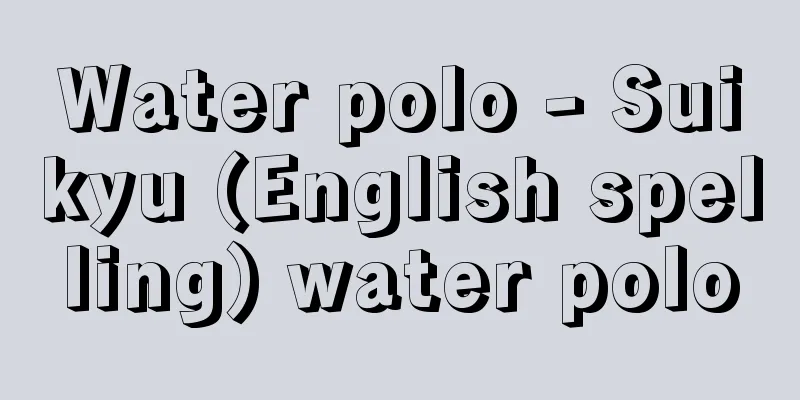Water polo - Suikyu (English spelling) water polo

|
A type of swimming competition. It is a ball game in which two teams compete for points by putting the ball into the opponent's goal underwater (in a pool). Since the ball is handled by hand, it is also called "underwater handball." It is an official Olympic event. [Katsumi Kuroda April 17, 2020] HistoryThe sport is said to have originally started in England, where players rode on floating barrels on the water and handled the ball with paddles, and it is said that the English name water polo was chosen after horseback polo. Drafts of the current rules began to be drawn up around 1870, but the Bournemouth Rowing Club in England established the rules in 1876, so this year is generally considered the first year of water polo. It then quickly spread across continental Europe, and men's water polo became an official event at the second Olympic Games in Paris in 1900. Water polo became the national sport of Hungary in particular, as handball was originally the national sport, and there are many natural hot springs throughout the country, making it possible to play in winter. In Japan, Keio University adopted the sport around 1910 (Meiji 43), after which it spread to other universities and developed rapidly. The first time a Japanese team participated in the Olympic Games was in 1932 (Showa 7), at the Los Angeles Games. [Katsumi Kuroda April 17, 2020] Current StatusInitially, it developed mainly in Europe, and is now also popular in the United States and Australia. Large-scale international competitions include the Olympics, World Championships, World Cup, and World League, and the world's strongest men's teams include Serbia, Montenegro, Hungary, Croatia, Italy, Greece, and Spain. In addition, Australia and Japan have also strengthened their strength since the 2010s, approaching the level of the European powers. For women, it became an official event at the Sydney Olympics in 2000, 100 years after the men's event, and other competitions, like the men's, have World Championships, World Cups, and World Leagues. Strong women's nations include the United States, Russia, Australia, Italy, and Greece, and there is a regional dispersion compared to the men's, where the top countries are concentrated in Europe. [Katsumi Kuroda April 17, 2020] Equipment and toolsAs long as there is at least one ball, hats to distinguish the teams, and a wooden frame 3 meters wide and 90 centimeters high to serve as a goal, the game can be played in a pool, river, or sea. In official matches, the competition field is a pool with a goal line of 30 meters for men and 25 meters for women, a width of 19 to 20 meters for both men and women, and a depth of at least 2.0 meters. Due to rule changes in 2019, it is desirable for official matches to have an area at least 1 meter wide outside the sidelines for flying substitutions, which can be made outside the sidelines. The equipment required for official matches includes a ball, 13 hats for each team (red and a contrasting color to the ball, as approved by the referee; only the goalkeeper will wear red), a pair of goals, a pair of shot clocks (30-second timers), two or more 8-minute timers, record paper, and a set of secretary's flags (red, white, blue, and yellow). [Katsumi Kuroda April 17, 2020] Competition MethodWater polo is a sport played on the aforementioned field between two teams of seven players each (six fielders and one goalkeeper), who compete to score points by shooting the ball into the opponent's goal. Each team has six substitutes, making a total of 13 players in each team. The game is played four times, each of eight minutes (one period), with two-minute breaks between the first and second periods and between the third and fourth periods. Teams switch sides during the breaks in the second and third periods, with three-minute breaks between them. There is no overtime, and in games that need to be decided, such as tournament games, a penalty shootout is played if the score is tied after four periods. In this case, each team designates five shooters. Each team can request two timeouts (one minute) during the game. Basic rules include that all players except the goalkeeper must handle the ball with one hand, that the goalkeeper must use both hands within his own six-metre line, and that he is allowed to hit the ball with his fist. Fouls include ordinary fouls, exclusion fouls, and penalty fouls. (1) Ordinary fouls are relatively minor fouls that result in a free throw being awarded to the opposing team. These include impeding the opponent's free movement, touching the ball with both hands at the same time, standing on the bottom of the pool, a false start at the start of each period, ball under the water (submerging the ball when tackled), and push-off (pushing an opponent attempting to tackle). In addition, the ball cannot be held for more than 30 seconds without a shot. If the offensive team regains possession of the ball after a corner throw or a shot, the offensive team is given another 20 seconds of possession. (2) Exclusion fouls The violator is expelled from the water and the opposing team is awarded a free throw. These include holding down, submerging, pulling back, or kicking an opponent who does not have the ball, and interfering with a free throw awarded to the opponent. These violators are ordered to be expelled from the water for 20 seconds. For disobedience to the referee or misconduct that brings the game to its knees, the player is ordered to be expelled from the water for the remaining time of the game with a substitute player. In addition, violent play or malicious punching, kicking, or attempting to punch or kick an opponent is called a brutal act. If this is done to an opponent or official (such as a game official including the referee or a bench official including the opposing team), if it is during the game, the violator is expelled from the water for the remaining time of the game and the opposing team is awarded a penalty throw. If it is during a stoppage in play or a timeout, the violator is expelled from the water for the remaining time of the game, but no penalty throw is awarded. In this case, the substitute player can enter the water four minutes after the foul. Additionally, any player who commits a brutal act will be suspended for at least one match from the next match onwards. (3) Penalty foul: A foul for which the opposing team is awarded a penalty throw from any point on the 5-meter line. If the defending team commits a foul within their own 6-meter line that would have otherwise resulted in a goal, the defending team is awarded a penalty foul and the attacking team is awarded a penalty throw. This includes the defending team moving or sinking the goal, attempting to block a shot or pass with both hands within the 6-meter line, and submerging the ball when the opponent tries to tackle and take the ball before the defending team has determined that they have new possession. If the defending team commits a brutal act such as hitting or kicking an opponent within the 6-meter line, in addition to the penalty throw, the player who committed the foul is suspended for the remaining time of the match. In addition, a player who commits an exclusion foul or a penalty foul will be recorded as a personal foul. If a player commits a third personal foul, he will be suspended for the remainder of the game. Also, if the ball goes out over the sideline, it is a free throw for the opposing team, and if it goes out over the goal line, it is a goal throw for the defensive team if the defense blocks an offensive shot, or a corner throw for the offensive team if the defensive goalkeeper releases the ball or if the defense passes the ball out over the goal line. The refereeing committee consists of two officials who have absolute authority over the game. In addition to the two referees, there are two goal judges who stand on the goal lines. In addition, there are two or three timekeepers who keep track of the net playing time, rest time, and the time each team has possession of the ball, and two secretaries who manage the time players are taken out of the water, record and manage personal fouls, and notify them. In addition, an official match will have one match manager (delegate), one referee, and one video assistant referee. [Katsumi Kuroda April 17, 2020] "Water Polo Handbook" compiled and published by the Japan Swimming Federation, a public interest incorporated foundation [References] | | [Additional Resources] |©Shogakukan "> Water polo stadium ©Shogakukan ©Mikasa "> Water polo ball ©Shogakukan "> How to handle a water polo ball Source: Shogakukan Encyclopedia Nipponica About Encyclopedia Nipponica Information | Legend |
|
水泳競技の1種目。水中(プール)で二つのチームが相手側ゴールにボールを入れて点数を競い合う球技。ボールを手で扱うことから、「水中のハンドボール」ともいわれる。オリンピックの正式種目となっている。 [黒田克己 2020年4月17日] 沿革元来、イギリスで水面に浮かべた樽(たる)に乗って櫂(かい)でボールを扱う形式で競技が始まったとされており、馬上で行うポロpoloに倣って、英語ではウォーター・ポロwater poloという名称になったといわれている。1870年ごろ現在につながるルールの草案が考えられ始めたが、1876年、イギリスのボーンマス・ローイング・クラブがルールを整備したので、一般にこの年を水球元年としている。その後、ヨーロッパ大陸に急速に普及し、1900年の第2回オリンピック・パリ大会で男子水球が正式種目になった。とくにハンガリーではもともとの国技がハンドボールであったこと、および国内各地に天然温泉が多数あるため、冬季でもプレーできることから、水球も同国の国技となった。 日本では、1910年(明治43)ごろ慶応義塾大学が採用し、その後各大学に広まり急速に発展した。日本チームのオリンピック参加は、1932年(昭和7)のロサンゼルス大会が最初である。 [黒田克己 2020年4月17日] 現況当初、ヨーロッパを中心に発展し、現在ではアメリカ、オーストラリアなどでも盛んになってきている。国際的な競技会としては、オリンピック、世界選手権、ワールドカップ、ワールドリーグなどの大規模なイベントが開かれているが、男子ではセルビア、モンテネグロ、ハンガリー、クロアチア、イタリア、ギリシア、スペインなどが世界の強豪といえる。加えて2010年代に入ってからオーストラリアおよび日本も力をつけ、ヨーロッパ列強のレベルに近づいている。 女子については男子に遅れること100年で2000年のオリンピック・シドニー大会から正式種目になり、そのほかの競技会も男子と同様、世界選手権、ワールドカップ、ワールドリーグが行われている。女子の強豪国としてはアメリカ、ロシア、オーストラリア、イタリア、ギリシアがあげられ、ヨーロッパに上位国が集中している男子に比べて地域的な分散がみられる。 [黒田克己 2020年4月17日] 設備と用具最小限、ボール1個と両チームを区別する帽子、ゴールになる幅3メートル、高さ90センチメートルの木枠さえあれば、プールでも川でも海でも遊ぶことができる。公式戦の場合には、両ゴールライン間が男子30メートル、女子25メートル、男女ともに幅19~20メートル、水深2.0メートル以上のプールが競技場となる。2019年のルール改定に伴い、公式戦の場合はサイドラインの外にフライング・サブスティテューションflying substitutionという、サイドライン外での交代を行うための最低1メートル幅のエリアがあることが望ましい。 用具は、ボール、帽子各チーム13(レフリーの認めた、赤色およびボールの色とは対照的な色。ゴールキーパーのみ赤)、ゴール1対(つい)、ショットクロック(30秒計)1対、8分計2個以上、記録用紙、セクレタリー用旗1組(赤白青黄)などが公式戦には必要になる。 [黒田克己 2020年4月17日] 競技方法水球は、前述の競技場で各7人(フィールダー6人、ゴールキーパー1人)からなる二つのチームの間で、ボールを相手側ゴールにシュートして得点を争う競技である。各チームには6人の交代要員がおり、総勢13人で1チームが構成される。競技は正味各8分(1ピリオド)ずつ4回行い、第1ピリオドと第2ピリオドの間および第3ピリオドと第4ピリオドの間に2分間ずつの休み時間を置く。チームのサイド交代は第2ピリオドと第3ピリオドの休憩時に行い、その間の休み時間は3分とする。延長戦は行われず、トーナメント戦のように勝敗を決する必要がある試合では4ピリオドの結果同点となった場合にはペナルティーシュート戦を行う。この場合、各チームは5人ずつのシューターを指名する。各チームは競技時間中にタイムアウト(1分間)を2回請求できる。 ルール上禁止されている基本的なものとして、ゴールキーパー以外は片手でボールを扱わなければならない、ゴールキーパーは自陣6メートルライン内で両手を使うこと、握りこぶしでボールを打つことが許されている、などがある。 反則にはオーディナリーファウル、エクスクルージョンファウル、ペナルティーファウルがある。 (1)オーディナリーファウル 比較的軽い反則で、相手方にフリースローが与えられる。相手の自由な動作を妨げること、両手で同時にボールに触れること、プールの底に立ってプレーすること、各ピリオド開始時のフライングスタート、ボール・アンダー・ザ・ウォーターball under the water(タックルされたとき、ボールを水中に沈めること)、プッシュオフ(タックルしようとする相手を押すこと)などがある。またシュートすることなしにボールを30秒以上保有することはできない。コーナースローやシュートをした後に、攻撃側チームが再度ボールを保持した場合は、攻撃側チームに新たに20秒のボール保有時間が与えられる。 (2)エクスクルージョンファウル 違反者は退水となり、相手方にフリースローが与えられる。ボールを持っていない相手を、押さえ、沈め、引き戻し、あるいはける動作をすること、相手に与えられたフリースローに対する妨害などがある。これらの違反者は20秒間の退水を命じられる。レフリーに対する不服従や試合をおとしめるような不行跡行為に対しては、交代競技者ありの残り試合時間中退水が命じられる。また、乱暴なプレーや、悪意をもって相手を殴る、ける、あるいは殴ろう、けろうとする行為をブルタリティ行為(暴力行為)といい、相手またはオフィシャル(レフリーを含む競技役員や、相手チームを含むベンチ役員など)に対してこれを行った場合、競技中であれば、違反者は残り試合時間中退水となり、相手方にペナルティースローが与えられる。プレー中断中、タイムアウト中などであれば、違反者は残り試合時間中退水となるが、ペナルティースローは与えられない。この場合、交代競技者はこの反則があった4分後に入水が可能となる。また、ブルタリティ行為を犯した競技者に対しては次の試合以降で最低1試合の出場停止処分が科される。 (3)ペナルティーファウル 相手方に5メートルライン上任意の地点からペナルティースローが与えられる反則。守備側が自陣6メートルライン内で、それがなければおそらく得点となると思われる反則を犯した場合に防御側にペナルティーファウルが判定され、攻撃側にペナルティースローが与えられる。この反則には防御側がゴールを動かしたり沈めたりする行為、6メートルライン内の位置で両手でシュートやパスのブロックを試みる、防御側の新たなボール保持が確定していない段階で相手がタックルしてボールを奪おうとしたときボールを水中に沈める、なども含まれる。防御側が6メートルライン内で、相手を殴ったり、けったりするブルタリティ行為を犯すなどした場合には、ペナルティースローに加え、反則を犯した競技者は残り試合時間中退水となる。 なお、前記エクスクルージョンファウルあるいはペナルティーファウルを犯した競技者にはパーソナルファウルが記録される。三つめのパーソナルファウルを科せられると、残り試合時間中退水となる。 また、ボールをサイドラインの外に出したときには相手方のフリースローとなり、ゴールラインの外に出したときは、攻撃側のシュートを防御側がブロックした場合は守備側のゴールスロー、守備側のゴールキーパーが出した場合、あるいは防御側がパスをゴールラインの外に出した場合は攻撃側のコーナースローになる。 審判は2名で行われ、競技について絶対的権限をもっている。この2名の審判員(レフリー)のほか、2名のゴールジャッジがゴールラインの延長上にいる。 このほか競技役員として、正味競技時間と休憩時間、各チームのボールの継続保有の時間を計るタイムキーパー2~3名、競技者の退水時間を管理し、パーソナルファウルを記録・管理し、それを通知する任務をもつセクレタリーが2名いる。加えて公式試合には試合統括者(デレゲート)と審判審査員およびビデオアシスタントレフリー各1名が配置される。 [黒田克己 2020年4月17日] 『公益財団法人日本水泳連盟編・刊『水球競技ハンドブック』』 [参照項目] | | [補完資料] |©Shogakukan"> 水球の競技場 ©Shogakukan ©ミカサ"> 水球のボール ©Shogakukan"> 水球のボールの扱い方 出典 小学館 日本大百科全書(ニッポニカ)日本大百科全書(ニッポニカ)について 情報 | 凡例 |
<<: Water buffalo - Water buffalo
>>: Pancreatic function test - Exocrine pancreatic function test
Recommend
Toraku
A method of expressing cultivated land area unique...
Impeachment
This is a system whereby Parliament prosecutes and...
Asteroid - Asteroid (English spelling) asteroid
A plane curve. It is expressed by the equation x ...
Cotton Fabric - Menorimono
A fabric made from cotton thread. It was already w...
kintract
...The basic function of a Japanese family and a ...
Nicolas Joseph Cugnot
French military engineer. Born in Meuse, died in ...
Vitrification - Touka (English spelling)
When a melt or a mixed solution is cooled, a kind...
Teuthoidea
…the general term for the living Sepioidea and Te...
Kiso Daikan
…A noble family that inherited the position of Ki...
Emphysema
What kind of disease is it? Main symptoms and cour...
Menyanthaceae
... Menyanthus trifoliata (genus Menyanthus), Iwa...
Sex - sei (English spelling) sex
The totality of characteristics that divide organi...
Kikuchi Kaisou
1799-1881 A Chinese poet from the late Edo to Mei...
Ukin rubbing - Ukin rubbing
…Many of them add a publishing note at the end of...
Philipp
...In particular, the fact that the Kingdom of Si...









